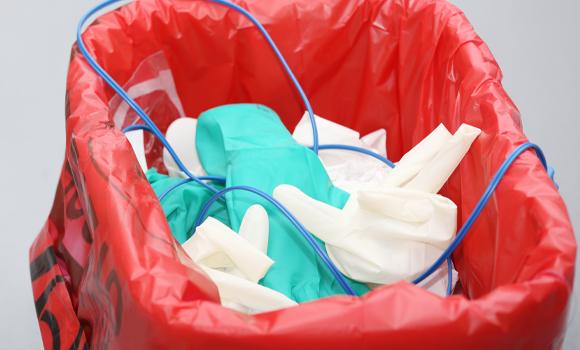Structured Solutions: Streamlining Medical Care Methods with Specialist Medical Waste Disposal
Structured Solutions: Streamlining Medical Care Methods with Specialist Medical Waste Disposal
Blog Article
Discovering Different Waste Disposal Options for a Cleaner Environment
In the search of a cleaner setting, the administration of waste disposal has actually emerged as an important focal point for sustainable growth. With a wide variety of waste disposal options readily available, varying from traditional land fill approaches to ingenious waste-to-energy innovations, the selection of how we handle our waste has significant implications for our earth's well-being.
Recycling Methods
Applying effective recycling methods is important in lessening waste and advertising sustainability in our environment. Reusing involves the process of converting waste products right into multiple-use challenge prevent unneeded disposal. Among the most usual recycling techniques is worldly recuperation, where materials like paper, glass, steel, and plastic are collected, arranged, and processed to develop brand-new items. This process not only saves all-natural sources but likewise reduces power intake and greenhouse gas exhausts related to creating brand-new products from the ground up.
One more important recycling technique is composting, which entails breaking down organic waste like food scraps and lawn trimmings right into nutrient-rich soil. This procedure not just diverts natural waste from garbage dumps but likewise generates a useful resource for gardening and agriculture. Furthermore, upcycling is a creative recycling approach that includes transforming old or discarded materials into products of better or value. By incorporating these various reusing approaches right into our waste monitoring methods, we can significantly decrease our environmental footprint and move towards an extra lasting future.

Composting Techniques
Effective waste monitoring practices, such as reusing approaches, pave the means for a cleaner environment, and currently, changing the focus to 'Composting Techniques', we discover sustainable ways to decay natural waste for environmental advantage. medical waste removal.
Composting is an all-natural process that changes organic waste, like food scraps and lawn trimmings, right into a nutrient-rich soil change. The key to effective composting depends on creating the ideal balance of environment-friendly materials, such as vegetables and fruit scraps, and brown products, like dried out twigs and fallen leaves. These materials disintegrate with the aid of bacteria, breaking down the waste into useful garden compost.
There are different composting strategies available to suit different needs. Conventional backyard composting includes layering organic materials in a bin or stack and frequently turning the combination to aerate it. Vermicomposting, on the other hand, utilizes worms to damage down natural issue into compost (click here). For those with limited room, interior composting systems provide a practical remedy. By utilizing composting methods, we can decrease the quantity of waste sent to garbage dumps while producing a valuable item for improving dirt and sustaining plant development.
Incineration Disadvantages and pros
Incineration, as a waste disposal technique, offers both advantages and drawbacks that warrant mindful factor to consider in the world of sustainable waste administration practices. On the silver lining, incineration can significantly decrease the quantity of waste, reducing the demand for garbage dump space and possibly decreasing greenhouse gas discharges. Incineration also permits the healing of energy through the generation of electricity or warmth, adding to resource recuperation. In addition, the procedure can be used to damage harmful substances, supplying a secure method for dealing with particular sorts of waste that might posture dangers to public health and wellness and the environment if left neglected.
However, there are significant drawbacks to incineration. One major problem is the prospective launch of damaging pollutants into the air, such as dioxins, hefty metals, and particulate issue, which can have damaging results on human wellness and the environment. Furthermore, the high first investment and operational expenses of incineration centers position financial challenges, making it a less economical option contrasted to various other waste monitoring strategies. Cautious surveillance and regulation are necessary to minimize these negative impacts and make the most of the benefits of incineration as part of a detailed waste here are the findings monitoring method.
Garbage Dump Administration Approaches
Land fills play an important role in waste monitoring and environmental preservation by giving a containment system for the disposal of solid waste materials. Efficient land fill monitoring strategies are important to mitigate ecological influences and guarantee the long-term sustainability of these waste disposal websites. One key strategy appertains waste compaction to optimize using readily available room within the landfill (click here). By compacting the waste, the quantity is minimized, enabling more waste to be suited over time.
Furthermore, the implementation of daily cover methods is important in lessening odors, stopping trash, and reducing the attraction of pests. Covering the disposed waste at the end of each day helps to contain smells and stop potential ecological contamination. Furthermore, the surveillance of land fill gas discharges and leachate degrees is important in making certain that ecological requirements are met and that any possible risks to bordering ecological communities are reduced.

Waste-to-Energy Technologies
One of the ingenious methods to squander monitoring entails taking advantage of Waste-to-Energy innovations to transform strong waste into usable power resources. Waste-to-Energy (WtE) modern technologies incorporate a range of procedures that intend to draw out energy from waste products with thermal, chemical, or organic ways. This conversion process not only decreases the quantity of waste that ends up in landfills however additionally generates beneficial power sources such as electricity, heat, or biofuels.
Incineration entails melting waste at high temperatures to generate heat and electrical power. Gasification converts waste right into a syngas, which can be made use of for power generation or chemical production.
Executing Waste-to-Energy modern technologies can help minimize ecological concerns connected with conventional waste disposal techniques while simultaneously supplying a sustainable energy resource. Careful consideration has to be offered to emissions control and ensuring the sustainability of feedstock materials for these modern technologies to be really beneficial for a cleaner atmosphere.

Verdict
In verdict, exploring various waste disposal choices such as reusing, composting, incineration, land fill management, and waste-to-energy innovations is important for advertising a cleaner setting - click here. Each technique has its very own benefits and challenges, but by using a combination of these strategies, we can work towards decreasing the quantity of waste that winds up in land fills and eventually add to an extra lasting future for generations to come
With a plethora of waste disposal choices readily available, ranging from traditional garbage dump techniques to ingenious waste-to-energy technologies, the selection of exactly how we handle our waste has far-ranging effects for our world's wellness. medical waste removal near me.Incineration, as a waste disposal method, offers both advantages and downsides that warrant cautious consideration in the world of sustainable waste management practices.Garbage dumps play an important function in waste administration and ecological preservation by providing a control system for the disposal of solid waste materials. By compacting the waste, the quantity is lowered, permitting for even more waste to be accommodated over time
One of the innovative techniques to squander management involves taking advantage of Waste-to-Energy innovations to convert strong waste right into usable power sources.
Report this page